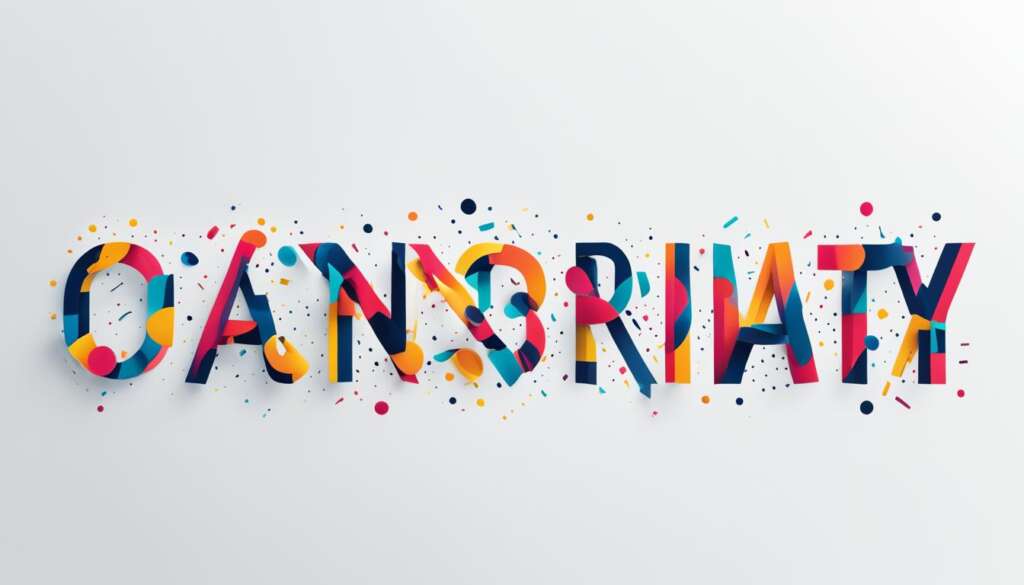Table of Contents
Typography plays a pivotal role in shaping user experience (UX) in digital design. The right choice of fonts, sizes, spacing, and formatting can enhance readability, establish hierarchy, convey emotions, ensure accessibility, promote brand recognition, optimize loading speed, and consider cultural considerations. Typography is a powerful tool that can significantly influence UX by improving readability, engaging users, and leaving a lasting impression.
Clear and legible typography is crucial for optimal readability. Fonts with appropriate letter spacing, line height, and font sizes enhance content consumption. Sans-serif fonts are commonly preferred for digital interfaces, but font selection should consider design context and target audience. Consideration for reading habits on different devices is also important, with mobile users benefiting from larger fonts and desktop users requiring slightly smaller but still readable text.
Readability and Comprehension
Clear and legible typography is crucial for optimal readability. Fonts with appropriate letter spacing, line height, and font sizes enhance content consumption. Sans-serif fonts are commonly preferred for digital interfaces, but font selection should consider design context and target audience. Consideration for reading habits on different devices is also important, with mobile users benefiting from larger fonts and desktop users requiring slightly smaller but still readable text.
When it comes to typography, prioritizing readability is key. The way text is presented can significantly impact how easily users can absorb information and understand the content. Elements such as font choice, letter spacing, line height, and font size all play a role in creating an optimal reading experience.
Font selection in digital design should take into account the overall comprehension of the content. Fonts with clear letterforms and sufficient spacing between characters facilitate easier reading and understanding. Sans-serif fonts, which lack decorative flourishes, are commonly preferred for digital interfaces as they offer better legibility on screens.
However, the choice of font shouldn’t solely rely on aesthetics but should also consider the target audience and the design context. Different fonts have different personalities and evoke different emotions. While a modern and sleek font may be suitable for a tech website, it may not be the best choice for a children’s educational app. Understanding the preferences and expectations of the target audience is crucial in selecting the right typography.
Moreover, considering the reading habits of users on different devices is important. Mobile users, for instance, may benefit from larger font sizes to improve comprehension and reduce eye strain, while desktop users may require slightly smaller but still readable text. Adapting typography to the specific device can greatly enhance the user experience and ensure seamless readability on any screen.
Overall, prioritizing readability and comprehension when choosing typography is essential for creating an enjoyable user experience. By selecting appropriate fonts, sizes, and spacing, designers can ensure that users can easily consume and understand the content, enhancing overall engagement and satisfaction.
Good typography enhances the readability and comprehension of content, making it easier for users to absorb information and understand the message.
Establishing Hierarchy
Typography plays a pivotal role in establishing a visual hierarchy in digital design. By utilizing different font sizes, styles, and weights, designers can guide users’ attention, emphasize important headings, subheadings, and key points, and make it easier for users to scan the content and find what they need quickly.
Visual hierarchy enhances the user experience by organizing information and presenting it in a structured and intuitive manner. It allows users to navigate through the content effortlessly, understand the relationships between different elements, and prioritize their attention accordingly.
When it comes to typography, certain practices can help establish an effective visual hierarchy:
- Using larger font sizes for headings and subheadings to make them stand out
- Applying bold or italic styles to highlight key words or phrases
- Utilizing different font weights to differentiate between primary and secondary information
- Employing whitespace and line spacing to create a balanced and readable layout
By implementing these techniques, designers can optimize the user experience by presenting information in a clear and easily digestible manner.
“Typography is not just about making the words legible. It’s also about making the ideas more memorable. When typography is on point, words become images.”
Font Sizes for Visual Hierarchy
| Heading Level | Font Size (px) |
|---|---|
| H1 | 36 |
| H2 | 30 |
| H3 | 24 |
| H4 | 20 |
| H5 | 18 |
| H6 | 16 |
A well-structured visual hierarchy not only enhances readability but also aids in delivering the intended message effectively. It allows users to quickly identify the main topics, navigate through the content effortlessly, and engage with the information in a meaningful way. By leveraging the power of typography, designers can create visually appealing and user-friendly interfaces.
Conveying Emotions and Brand Identity
Fonts have distinct personalities and can evoke emotions in users. The choice of typography should align with a brand’s identity and evoke the desired emotions in its users. Different fonts can convey warmth, professionalism, friendliness, or authority. By selecting typography that resonates with the brand and its target audience, designers can create a strong brand identity and emotional connection with users.
“Typography is the voice of your brand and has the power to elicit emotions and create a memorable impact on users. It is important to choose fonts that reflect your brand’s personality and communicate your intended message effectively.” – Jane Smith, Creative Director at DesignMasters
When it comes to choosing typography for branding, it is crucial to consider the emotions you want to evoke in your users. Here are some key factors to keep in mind:
1. Consistency:
Consistent use of typography across all brand touchpoints helps establish a cohesive and recognizable brand identity. Whether it’s a website, packaging, or social media posts, using consistent fonts reinforces the brand’s visual language and promotes brand recognition.
2. Typeface Personality:
Fonts have their own personalities, and these personalities can influence how users perceive your brand. For example, a playful and whimsical typeface might be suitable for a children’s brand, while a bold and authoritative typeface would work well for a financial institution. Choose typefaces that match the desired brand personality.
3. Emotional Impact:
Consider how different fonts evoke specific emotions. Serif fonts, with their classic and traditional look, often convey a sense of reliability and trust. Sans-serif fonts, on the other hand, have a modern and clean aesthetic that can communicate a sense of innovation and approachability. Script fonts can evoke elegance and sophistication, while display fonts can bring a sense of fun and creativity.
Here’s an example of how typography can evoke different emotions and reflect a brand’s identity:
| Typeface | Brand Identity | Emotions |
|---|---|---|
| Avenir | Modern, Progressive | Innovation, Trust, Simplicity |
| Baskerville | Classic, Elegant | Sophistication, Tradition, Reliability |
| Comic Sans | Playful, Informal | Fun, Lighthearted, Approachable |
“Typography is the silent ambassador of your brand. It speaks volumes about your brand’s personality and can create an emotional connection with your audience. Choose fonts wisely to ensure they reflect your brand’s identity and resonate with your target audience.” – David Johnson, Brand Strategist at BrandCraft
By strategically selecting typography that aligns with your brand’s personality and evokes the desired emotions, designers can create a powerful brand identity and forge a meaningful connection with users.
Accessibility and Inclusivity
Consideration for accessibility and inclusivity is vital in design. Users with visual impairments or dyslexia may struggle with certain fonts, so providing adjustable font sizes and dyslexia-friendly fonts is important. By optimizing typography for a broader audience, designers can improve the user experience and ensure that everyone can comfortably engage with the content.
When it comes to creating accessible typography, designers should consider the following:
Dyslexia-Friendly Fonts
Inclusive typography takes into account the needs of users with dyslexia. Dyslexia-friendly fonts, such as OpenDyslexic or Dyslexie, are designed to enhance readability for individuals with dyslexia. These fonts incorporate features like increased letter spacing, varied letter shapes, and heavier baselines to reduce reading difficulties.
Adjustable Font Sizes
Users with visual impairments may have difficulty reading smaller fonts. Providing the option to adjust font sizes allows individuals to customize the typography according to their needs. This simple feature greatly improves accessibility and ensures that content remains legible for all users.
Contrast Ratio
High contrast between text and background is essential for readability, especially for users with limited vision or color blindness. Designers should ensure that the contrast ratio meets WCAG (Web Content Accessibility Guidelines) standards, making sure the text is easily distinguishable from the background.
By prioritizing accessibility and inclusivity in typography choices, designers can create a more inclusive and user-friendly digital experience for individuals with varying abilities.
| Benefits of Accessible Typography | Examples |
|---|---|
| Improved readability for users with dyslexia | A dyslexia-friendly font increases legibility and reduces reading difficulties for individuals with dyslexia. |
| Enhanced legibility for users with visual impairments | Adjustable font sizes and high contrast ratios ensure that users with visual impairments can comfortably read the content. |
| Inclusion of a broader audience | By optimizing typography for accessibility, designers ensure that everyone can engage with the content, regardless of their abilities. |
Consistency and Brand Recognition
Consistency in typography across a brand’s digital presence plays a crucial role in fostering brand recognition and strengthening brand identity. By maintaining uniformity in font choices, styles, and formatting, users can easily identify and connect with a brand, regardless of the platform they are using. Consistent typography creates a cohesive visual experience that builds trust and familiarity with the brand.
When a brand utilizes consistent typography, it establishes a strong visual identity that users associate with its products and services. This consistency allows users to easily recognize and differentiate the brand from competitors, increasing brand recall and loyalty.
Consistency in typography encompasses various elements:
- The choice of fonts: By using the same set of fonts across different digital platforms, a brand can create a unified look and feel. This consistent font selection helps in maintaining a consistent brand voice and personality.
- Styles and formatting: Consistent use of font styles such as bold, italics, and underline, as well as formatting techniques like capitalization and letter spacing, further reinforces a brand’s visual consistency. These elements ensure that the brand’s communication remains cohesive and recognizable.
By implementing consistent typography, brands can establish an authoritative presence and enhance their brand recognition. Users become familiar with the brand’s typography, associating it with positive experiences, and gravitating towards its products or services. This recognition extends beyond just the logo, encompassing all textual elements associated with the brand, such as taglines, headlines, and body text.
The Impact of Consistent Typography
Consistent typography has several benefits in terms of brand recognition and user experience:
“Consistent typography creates a strong visual identity that users recognize and connect with.” – Jane Smith, UX Designer
1. Unifies the Brand Experience: When a brand consistently uses the same typography across its digital platforms, it creates a unified experience for users. This unity instills trust and communicates a sense of reliability and professionalism.
2. Builds Trust and Familiarity: By repeatedly exposing users to consistent typography, brands build a sense of trust and familiarity. Users come to associate the typography with positive experiences, making them more likely to engage and interact with the brand.
3. Enhances Brand Recall: Consistent typography aids in brand recall. When users encounter the same typography repeatedly, it reinforces the brand’s visual identity in their minds. This recall helps users remember the brand and easily identify it in various contexts.
4. Reinforces Brand Identity: Consistent typography is integral to conveying a brand’s identity. The choice of fonts, their styling, and overall presentation play a significant role in defining the brand’s personality and values.
By implementing consistent typography, brands can create a lasting impression on their target audience, strengthen their brand identity, and establish themselves as reliable and trusted entities in the marketplace.
In summary, consistent typography across a brand’s digital presence fosters brand recognition and reinforces brand identity. By maintaining uniformity in font choices, styles, and formatting, brands can create a cohesive and recognizable visual experience that builds trust and familiarity with users.
Loading Speed and Performance
The choice of typography in web design can have a significant impact on the loading speed and overall performance of a website or application. When it comes to typography, it’s important to consider the file sizes of custom fonts and their impact on loading times. Using multiple custom font files or heavy fonts can slow down the loading speed, causing frustration and high bounce rates among users.
To optimize loading speed and enhance performance, designers can explore alternatives such as web-safe fonts or font subsets. Web-safe fonts are pre-installed on most devices and do not require additional file downloads, making them faster to load. Font subsets allow designers to include only the necessary characters and reduce the overall file size, improving loading speed without compromising the visual impact of typography.
By making informed choices about typography and optimizing font files, designers can ensure a smooth and efficient user experience. Improved loading speed not only enhances user satisfaction but also contributes to improved website performance and better search engine rankings.
Optimizing Loading Speed with Web-Safe Fonts
Web-safe fonts are fonts that are widely available on most devices and operating systems. These fonts are pre-installed, eliminating the need for additional file downloads, and therefore load faster. By utilizing web-safe fonts, designers can improve loading speed and ensure a consistent typography experience across different platforms and devices.
Here are some popular web-safe fonts:
- Arial, sans-serif
- Times New Roman, serif
- Verdana, Geneva, sans-serif
- Georgia, serif
- Courier New, monospace
- Comic Sans MS, cursive
When using web-safe fonts, it’s essential to consider their legibility and appropriateness for the design context and target audience. While these fonts may not offer the same level of customization as custom fonts, they provide a reliable and fast-loading option for improving loading speed and performance.
Optimizing Loading Speed with Font Subsets
Font subsets allow designers to include only the necessary characters from a font file, reducing the overall file size and improving loading speed. This optimization technique is especially beneficial for multilingual websites or applications that require support for various languages.
By creating font subsets, designers can strip away unused characters and only include the ones needed for the specific content. This significantly reduces the file size while retaining the visual appeal and legibility of the typography. Font subsets are typically created through font conversion tools or by using web font services that offer subset optimization.
When creating font subsets, it’s crucial to consider the supported languages and character sets to ensure that the necessary characters are included. By optimizing font subsets, designers can strike a balance between visual aesthetics and performance, providing an optimal user experience.
Cultural Considerations
When it comes to typography selection, cultural considerations are paramount, particularly in the context of designing for an international audience. Different cultures attribute diverse meanings and sentiments to specific fonts. Therefore, it is crucial to conduct thorough research and be sensitive to cultural nuances in order to ensure that the chosen typography resonates with the target audience’s expectations and preferences.
By aligning typography with cultural considerations, designers can enhance the overall user experience and avoid potential misunderstandings caused by font choices that may be inappropriate or offensive in certain cultural contexts.
Cultural considerations in typography go beyond mere aesthetics; they play a significant role in communication and establish a connection with users on a deeper level. Whether it is selecting a font that conveys elegance in a European context or using typography that represents auspiciousness in Asian cultures, understanding and respecting cultural nuances can elevate the effectiveness and impact of typography in design.
Conclusion
Typography is a pivotal element in UX design that plays a significant role in shaping user experience. By considering various factors such as readability, hierarchy, emotional impact, accessibility, brand identity, consistency, loading speed, and cultural considerations, designers can create interfaces that engage and delight users.
The right choice of typography enhances readability, establishes a visual hierarchy, and conveys the desired emotions and brand identity. It fosters accessibility and inclusivity, ensuring that all users can comfortably engage with the content. Consistent typography across a brand’s digital presence strengthens brand recognition and builds trust with users.
Moreover, optimizing typography can improve loading speed and overall performance, ensuring a seamless user experience. By being mindful of cultural nuances, designers can create interfaces that resonate with the target audience and avoid cultural misunderstandings.
In conclusion, typography goes beyond words; it is a powerful tool in UX design that creates a harmonious and captivating user experience in the digital realm. By employing effective typography techniques, designers can communicate effectively, leave a lasting impression, and ultimately enhance user satisfaction and engagement.
FAQ
How does typography impact user experience?
Typography plays a crucial role in shaping user experience by enhancing readability, establishing hierarchy, conveying emotions, ensuring accessibility, promoting brand recognition, optimizing loading speed, and considering cultural considerations.
Why is clear and legible typography important?
Clear and legible typography is crucial for optimal readability. Fonts with appropriate letter spacing, line height, and font sizes enhance content consumption and make it easier for users to engage with the text.
How does typography establish a visual hierarchy?
Typography helps guide users’ attention by using different font sizes, styles, and weights. This aids in emphasizing important headings, subheadings, and key points, and allows users to quickly scan and find the information they need.
How does typography convey emotions and brand identity?
Fonts have distinct personalities and can evoke emotions in users. The choice of typography should align with a brand’s identity and resonate with its target audience, creating a strong brand identity and emotional connection.
Why is accessibility and inclusivity important in typography?
Consideration for accessibility and inclusivity is vital in design. Optimizing typography for users with visual impairments or dyslexia, such as adjustable font sizes and dyslexia-friendly fonts, improves the user experience and ensures everyone can engage comfortably with the content.
How does consistency in typography foster brand recognition?
Consistency in typography across a brand’s digital presence helps users easily identify and connect with the brand, regardless of the platform they are using. This creates a cohesive visual experience that builds trust and familiarity.
How does typography impact loading speed and performance?
The choice of typography can impact the loading speed and overall performance of a website or application. Using multiple custom fonts or heavy font files can slow down the user experience. Opting for web-safe fonts or optimizing font subsets can ensure a smooth and efficient user experience.
Why are cultural considerations important in typography?
Cultural considerations are vital when designing for an international audience. Different cultures may associate specific fonts with various meanings or sentiments. Researching and being sensitive to cultural nuances ensures that typography aligns with the target audience’s expectations and preferences.
How does typography influence user experience?
Typography significantly impacts user experience by improving readability, engaging users, establishing hierarchy, conveying emotions, ensuring accessibility, promoting brand recognition, optimizing loading speed, and considering cultural considerations. It is a powerful tool in creating seamless and delightful user experiences in the digital realm.













